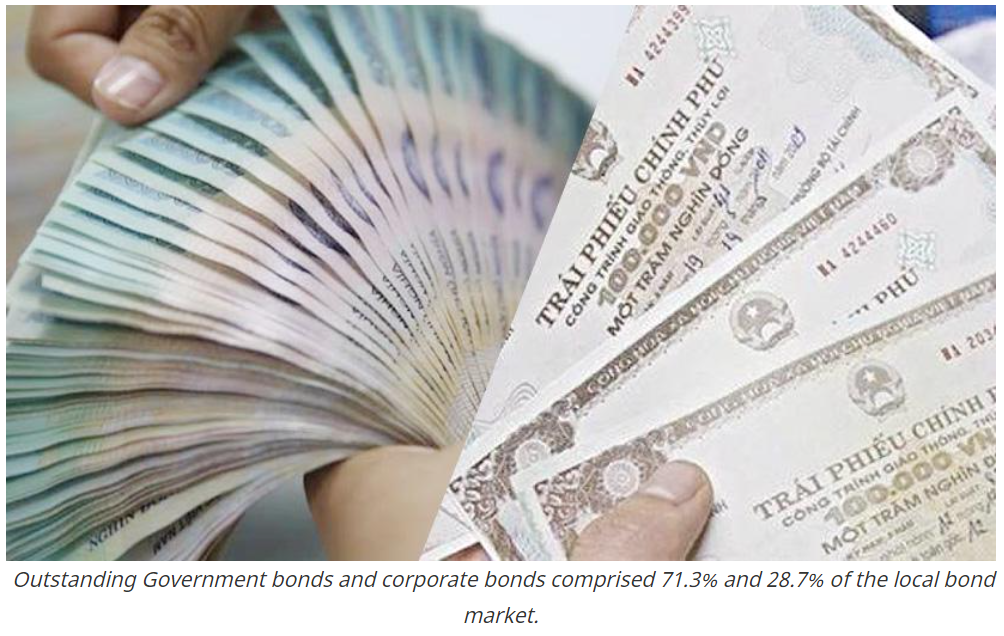Vietnam bond market rises to US$91.5 billion in 2021: ADB
At the end of 2021, outstanding Government bonds and corporate bonds comprised 71.3% and 28.7% of the local bond market, respectively.
Vietnam’s local currency (LCY) bond market grew 9.8% quarter-on-quarter to reach VND2,089.1 trillion (US$91.5 billion) at the end of 2021, and annual growth expanded by 25.5%, according to the latest report of the Asian Development Bank (ADB)’s Asia Bond Monitor.
“The quarterly growth was driven by both Government and corporate bonds, with outstanding bonds in these segments increasing 5.3% and 22.7% quarter on quarter, respectively, which in both cases was a faster growth rate than in the previous quarter,” noted the report.
According to the ADB, outstanding Government bonds and corporate bonds comprised 71.3% and 28.7% of the local bond market, respectively, at the end of December 2021.
Corporate bond issuance in Vietnam jumped 30.8% quarter-on-quarter in the fourth quarter of 2021 to VND123.4 trillion ($5.4 billion) as more firms turned to the bond market to raise funds.
“The largest debt issuers in the fourth quarter were mainly from the property sector,” stated the ADB.
The top 30 corporate issuers had aggregate LCY bonds outstanding of VND358.7 trillion ($15.7 billion) at the end of December, accounting for 59.8% of the total LCY corporate bond market.
About 75% of the top 30’s debt stock was issued by banks, totaling VND275.4 trillion, while property firms had the second-highest share at 13.2% (VND47.3 trillion).
All firms with more than VND10 trillion of outstanding bonds were from the banking sector except Masan Group. The Bank for Investment and Development of Vietnam (BIDV) was the largest issuer in the top 30 list with total bonds outstanding of VND37.2 trillion at the end of the fourth quarter of 2021.
Financial conditions in emerging East Asia remain robust
Looking at the region, emerging East Asia’s total local currency bond issuance rose 7.1% to an all-time high of $9 trillion in 2021.
For the last three months of the year, emerging East Asia’s local currency bond stock grew 3.6% from the previous quarter to $22.8 trillion. Bond yields in the region rose between November 30 and March 9, amid global inflationary pressure and rising yields in advanced markets.
“Financial conditions in emerging East Asia remain robust, backed by ample liquidity,” said ADB Chief Economist Albert Park. “Most central banks in the region have maintained accommodative monetary stances, even as advanced economies tightened policies. However, continued inflationary pressure may cause more central banks around the world to tighten, which could reduce liquidity and weaken financial conditions.”
Risk premiums have edged up amid dampened investor sentiment due to expected monetary tightening by the US Federal Reserve and the Russia-Ukraine conflict.
The Federal Reserve hiked interest rates on March 16 for the first time since 2018 and signaled additional increases on the horizon as inflation picks up, partly due to war-related increases in oil and food prices. Global supply chain disruptions and the uncertain trajectory of the Covid-19 pandemic are also threatening the global economic outlook.
ASEAN member economies saw record-high local currency bond issuance of $1.5 trillion last year. That accounted for 17% of the total issuance in emerging East Asia, which comprises China; Hong Kong, China; Indonesia; South Korea; Malaysia; the Philippines; Singapore; Thailand; and Vietnam.
Sustainable bond stock in the ASEAN region plus China; Hong Kong, China; Japan; and South Korea rose to $430.7 billion at the end of 2021 from $274.1 billion a year earlier. Green bonds continue to dominate the region’s sustainable bond market, accounting for 68.2% of the total, although interest in social and sustainability bonds is also growing.
Source: Hanoi Times


 Thailand
Thailand




